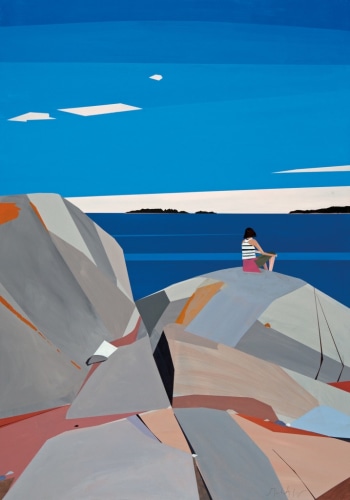
Greta Van Campen, Molly, Birch Island, Acrylic on panel, 34″ x 24″
by Britta Konau
When confronted with the beauty of Maine’s coast, most painters, whether working plein-air or in the studio, respond with loaded brushes and an impressionistic style that well captures atmospheric conditions and light reflections. Not so Greta Van Campen. The young midcoast native has developed a style of her own that is all flat, angular planes and smoothly applied paint. At least at first glance.
Van Campen’s show at Rockland’s Dowling Walsh Gallery focuses on local subjects – quite the departure from her previous paintings, executed during a whirlwind tour of all 50 states. With the exception of a few still lifes, which could have been created anywhere, views of the Penobscot Bay and its islands abound. The paintings contain all the essentials of a Maine coastal scene: ocean, islands, rocks, pine trees, the sun’s reflection on water. Her particular stylistic approach abstracts these forms and spatial configurations into facets of color and space of pleasing graphic clarity. This distillation retains enough detail, however, to strike a perfect balance between the universal and the particular, so that the views remain identifiable.
Van Campen is related to Precisionist painter George Ault (1891-1948) and grew up with a few of his works. Recently, she has acknowledged a certain affinity to his choice of subject matter and style. Developed in the 1920s, Precisionism celebrated the American urban, architectural and industrial landscape. Paintings ruled by precise description but geometric simplification stripped their subjects of any detail, often to the point of severity, and flattened out space. Charles Sheeler and Charles Demuth were the foremost practitioners of Precisionism, but Ault found a niche of his own painting stylized rural scenes around Woodstock, New York, during the 1940s.
Van Campen utilizes a comparable hard-edged style, but hers is occasioned by decisions of design and process rather than ways of seeing and experiencing the world. “Basin Preserve, Vinalhaven” is an acrylic on panel that breaks into pink and blue horizontal slivers of light and its watery reflection, which are interrupted by a few dark landmasses, islands near and far, solidifying into jagged verticals. Painted edges are not immaculate and small details, including what may be floating seaweed or rocky outcroppings, breaking up the water’s smooth surface, add liveliness and imbue the work with a feeling of having been there.
In Van Campen’s case, knowing the artist’s working process helps appreciating the work. She explained to me in a recent phone conversation that she uses her own photographs as the starting point. Without the use of preliminary drawings she decides on large compositional elements and dynamic lines. Successively painting in layers and masking off entire areas or smaller details with washi tape, a thin masking tape made of rice paper, the painting becomes more and more detailed. Previous, now overpainted shapes often remain discernible as slight ridges, paint that accumulated along the tape. In the small “Still Life 2,” a table’s edge thus appears to physically continue through a couple of potted plants. This construction of space seems to make sense mentally, even if it is not the way we see it.
Van Campen’s process of painting does not lend itself to depicting movement and human or canine anatomy, but for most works the approach is successfully expanded to freehand painting, including the overcast sky in “Late Day Paddle to the Island.” The lower portion of this unusually elongated composition also contains an interesting example of a very free use of the masking tape as painting tool. Painting with green over torn pieces of tape yields an organic suggestion of vegetation after their removal. Elsewhere, torn tape is used to evoke the jagged outline of pine trees.
Due to the angularity of their compositional elements, Van Campen’s paintings often read like paper collages. Just like them, her paintings are not about convincing likeness but analytical deconstruction and reassembly, not in a cerebral sense but a visual and spatial one. While the artist makes adjustments to her process and style in the interest of creating more dynamic images, these don’t feel like compromises, but like being in full control. There is, in fact, a wonderful and impressive confidence in Van Campen’s paintings.